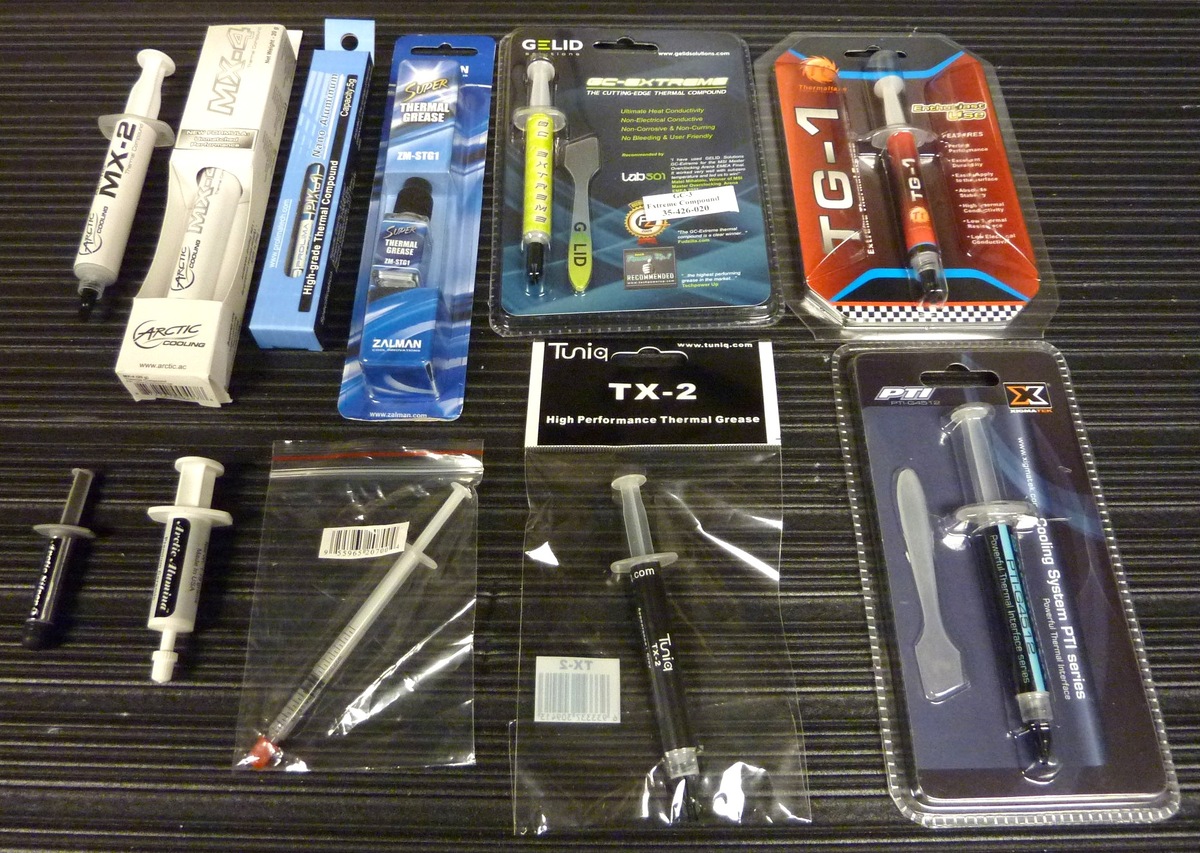Table of Contents
Introduction
While not quite as important as having a high quality heatsink, thermal paste plays a very important role in keeping your CPU (or video card) running cool. A few weeks ago, we looked into the proper techniques for applying thermal paste. In this article, we will be using what we learned to properly test a number of popular thermal pastes.
Test Thermal Pastes
There are a huge number of brands and models of thermal paste available, so choosing which ones to test is a job unto itself. We want our selection to include both what is frequently recommended on forums as well as what should perform the best based on reviews (both consumer and professional). We ended up with eleven different thermal paste models to test, including the ARCTIC MX2 which is our current go-to thermal paste here at Puget Systems.
| Model | Part # | Approx. Price | Size | Price/gram |
| ARCTIC MX2 | MX-2 | $10.99 | 4g | $2.75 |
| ARCTIC MX4 | ACT-MX4 | $9.99 | 4g | $2.50 |
| Arctic Silver 5 | AS5-3.5G | $9.99 | 3.5g | $2.85 |
| Arctic Silver Arctic Alumina | AA-1.75G | $4.90 | 1.75g | $2.80 |
| GELID Solutions GC-Extreme | GC-Extreme | $12.99 | 3.5g | $3.71 |
| MASSCOOL G751 | G751 | $6.99 | .5g | $13.98 |
| Prolimatech PK-1 | PRO-PK1-5G | $9.99 | 5g | $2.00 |
| Thermaltake TG-1 | CL-O0027 | $15.99 | 4g | $4.00 |
| Tuniq TX-2 | TX-2 | $6.99 | 3.5g | $2.00 |
| XIGMATEK PTI-G4512 | PTI-G4512 | $8.99 | 4g | $2.25 |
| Zalman STG1 | ZM-STG1 | $9.99 | 3.5g | $2.85 |
Many of these thermal pastes come in multiple sizes, but in the chart above we tried to keep to the ones that are around 4g in size if possible. For end-users, this is a great size to purchase since you should be able to get 4-5 applications out of a single tube. This gives you the chance to install the heatsink with the thermal paste, then remove the heatsink to make sure you are getting good coverage (not too much and not too little). Then, after cleaning off the first application, you can make adjustments to apply more or less thermal paste to get perfect coverage.
Out of the pastes we are testing, the two cheapest options per gram are the Prolimatech PK-1 and the Tuniq TX-2, each at $2 per gram. The three most expensive are the GELID Solutions GC-Extreme ($3.71 per gram), the Thermaltake TG-1 ($4.00 per gram), and the MASCOOL G751 ($13.98 per gram!). Whether or not these more expensive options are worth it will be decided when we perform our thermal testing.
Test Setup
Each thermal paste was applied used an X-shape pattern. In our recent article, Thermal Paste Application Techniques, we found that this pattern was the best method for applying thermal paste as it results in an even spread with very few air bubbles.
For our test hardware, we will be using the following components:
|
|
||||||||||||||||
CPU temperatures were recorded with a combination of CoreTemp and Speedfan with the temperature reported as the average of the four cores. We let the system idle for at least 30 minutes before recording the idle temperatures, and to put the system under 100% load we ran a combination of both Prime95 and Furmark. Dynamic fan ramping was disabled from the motherboard since we are primarily concerned about the variances in temperature between each application technique and do not want the fan throttling to affect our results.
We are using the built in video controller to help put just a little extra load on the CPU which should accentuate any temperature variances. An open-air test platform was used in place of a chassis since it should allow for more consistent results.
The margin of error for our testing is .5 °C
Thermal Results
Thermal testing is about as straight-forward as it gets when it comes to PC testing. The only thing to remember is that load results are much, much more important than idle results. So, based on the load results, we can determine that the ARCTIC MX2 and the GELID Solutions GC-Extreme are the best performing thermal pastes out of those we tested. However, the Prolimatech PK-1, Thermaltake TG-1, and Tuniq TX-2 are only .5 °C behind which is within our margin of error.
Conclusion
We were expecting the ARCTIC MX2 to be among the top performers since it has already passed our qualification process, but frankly we were surprised that none of the more expensive thermal pastes were able to best it. If you are purchasing thermal paste for your own system, however, the ARCTIC MX2, GELID Solutions GC-Extreme, Polimatech PK-1, Thermaltake TG-1 and Tuniq TK-2 are all excellent choices. A difference of .5 °C is so minor that it can be attributed to normal testing variations, so you really cannot go wrong with any of those five thermal pastes.
For us at Puget Systems, our testing has shown that there is no reason to move away from the ARCTIC MX2 thermal paste. We know that it is among the best performers currently available and we also know that that it has great longevity based on the state of the paste on machines that have come back for repairs or upgrades. And the fact that we can purchase it in bulk with large 30g or 65g tubes is really just icing on the cake.
